City of Carlisle Electric Tramways
History
The promoters of Carlisle's electric tramway successfully obtained powers to build a system in the town in 1898, the corporation lending their support in exchange for a binding commitment to buy electricity from them (amongst other things). On the 16th June 1899, the City of Carlisle Electric Tramways Company was registered to raise the necessary capital, acquire the existing powers (from the promoters), and then build and operate the tramway. Construction work on the 3ft 6ins-gauge overhead electric tramway commenced on the 4th September 1899, the opening taking place almost 9 months later on the 30th June 1900.
The tramway was only 5.73 miles long, and was never extended. It was centred on Carlisle Citadel Station, and comprised lines: northwards to Stanwix along Lowther St; eastwards along Warwick Rd to Petteril Bridge; southeastwards along Botchergate to a terminus on London Rd just after the bridge across the North Eastern Railway, with a branch southwards from London Rd, along Blockwell Rd to Boundary Rd; southwards along Denton St to Denton Holme; and westwards along Newtown Rd to Newtown. It was worked by 15 tramcars, which arrived in two batches in 1900.
The original company always struggled financially, the last dividend, and a pitiably small one at that, was paid in 1906. There were several reasons for this, but first and foremost was the small population served and the high cost of electricity, which the company purchased from corporation, doubtless at a rate that was advantageous to the latter. The company reacted by cutting back on maintenance, and by 1910, both the track and the cars were in extremely poor condition, and the spectre of expensive renewals was looming large. At this point, the directors recommended selling the company, and perhaps surprisingly, they found a buyer, in the form of Balfour Beatty and Company, who took control in November 1911.
Balfour Beatty and Company had been actively promoting, purchasing, or acquiring interests in several provincial tramways across the country, a policy which would eventual see it control the following systems: 1909 (Dartford Council Light Railways; Dunfermline and District Tramways; Llandudno and Colwyn Bay Electric Railway; Llanelly Tramways; Luton Corporation Tramways); 1911 (City of Carlisle Electric Tramways); 1912 (Leamington and Warwick Electric Tramways; Mansfield and District Light Railway; Nottinghamshire and Derbyshire Tramways); 1914 (Cheltenham and District Light Railway); 1920 (Falkirk and District Tramways); and lastly, in 1922 (Wemyss and District Tramways).
The new owners immediately negotiated a reduction in the electricity price, then set about what was virtually a complete renewal of the system, including track, overhead and the entire tramcar fleet (12 new cars), the rebuilt tramway being relaunched on the 9th December 1912. The system managed a couple of years of steady operation before it was once again plunged into a period of low maintenance and 'make do and mend', this time caused by events completely beyond its control, namely, the Great War. Like most other tramway concerns across Britain, the system emerged from the conflict in badly run-down condition. Moreover, the system had failed to keep pace with housing developments in the city and its environs, so was poorly placed to serve the population, unlike the independent and unregulated bus operators who were shortly to appear. All that was done to improve matters was to acquire three reconditioned ex-Ilkeston Corporation tramcars from the Nottinghamshire and Derbyshire Tramways Company — another Balfour Beatty and Company concern — in 1920 and 1921.
By the mid-1920s, the writing was on the wall; although the company managed to avoid making a loss, it was never going to be in a position to fund the large capital outlay that would be needed to renew the track or to extend the lines to better serve the population. Although it changed its name in April 1926 — to the Carlisle and District Transport Company Ltd — no doubt reflecting an aspiration to introduce bus services, the company never took this step within the city.
In early 1931, the corporation reached agreement to purchase the tramway, which it intended to replace with municipally operated motorbuses. The Northern Traffic Commissioners, however, quickly threw a spanner in the corporation's works, by refusing to grant them the bus operating licences that they would need. After a short period of reflection, the corporation decided that its best course of action would be to take on a transport co-ordination role; this allowed Ribble Motor Services of Preston to acquire the tramway company (it had already acquired several independent motorbus operators in the area), its intention also being to close it and replace the services with motorbuses.
The last Carlisle tram ran on the 21st November 1931, with buses taking over the following day.
Uniforms
The earliest photos of Carlisle tramcar crews show them wearing single-breasted jackets with five buttons — presumably bearing the full title and monogram (see link) — and stand-up collars; it is unclear if the latter carried any badges. Caps were initially soft-topped with a glossy peak; they bore a large round cap badge comprising an armorial device (no doubt unofficial) surrounded by the full company title set within a garter (see below for an example). The design was very similar to that used by the Blackpool and Fleetwood Tram Road Company (see link), possibly due to the influence of Mr G Readman, who was a director of both enterprises.
A staff photograph taken in 1904 (not shown) shows that these early uniforms did not last long, being replaced by double-breasted lancer-style tunics with five pairs of buttons — narrowing from top to bottom — and stand-up collars; the latter bore an employee number on the left-hand side, probably in individual nickel numerals, and system initials on the right-hand side, possibly 'C E T', though this cannot be made out with certainty on surviving photographs. The caps were also changed — probably at the same time — to a drooping-peak type with piping, but retaining the prominent round cap badge.
The drooping-peak caps appear not to have lasted long, as photos taken from 1905 onwards show individuals wearing peaked caps with tensioned crowns (tops). The large round cap badges were eventually superseded by standard, off-the-shelf, script-lettering grade badges — 'Motorman' or 'Conductor' — more than likely in nickel. It is, however, currently unclear exactly when this occurred, as the photographic record between 1908 and 1927 is sparse in the extreme, though a reasonable candidate would be soon after 1911 when the tramway was taken over by Balfour Beatty and Company. By the latter years of the tramway, and possibly since the BB&Co take-over, the style of jackets worn by conductors had changed to a fairly standard single-breasted design with five buttons, stand-up collars and epaulettes; the collars probably bore an employee number on the bearer's left-hand side and 'C E T' initials on the right.
Tramcar crews were also issued with double-breasted greatcoats with five pairs of buttons, epaulettes and high-fold-over collars; the epaulettes possibly bore an employee number.
The company also employed the services of messenger boys, who worked in support of the company's successful parcels and messages service, which began in 1906, Unfortunately, no photographs of these lads have survived, so it is impossible to say what uniforms they wore.
Edwardian photographs show staff wearing round licence badges — almost certainly brass — which were suspended from a button on the bearer's tunic or from a cash-bag strap in the case of conductors. As the years wore on, the wearing of these licences appears to have been at best sporadic. Several examples of alloy armbands have also survived — specifically marked 'TRAM CAR' — though these are not seen in any of the surviving photographs. One possible explanation is that they were only in use for a short period, as they probably required two people to buckle up, and even then they must have had a tendency to slip down the bearer's arm.
Inspectors wore single-breasted jackets with hidden buttons (or more likely a hook and eye affair) and stand-up collars, all edged in a finer material than the main body of the jacket; the collars bore 'Inspector' in embroidered script lettering on both sides. In the early years, inspectors wore drooping-peak caps that bore the same prominent cap badge as used by tramcar crews, but with 'Inspector' on a hat band beneath, probably embroidered. At some point, the drooping-peak caps were superseded by tensioned-crown peaked caps, possibly at the same time the large round cap badge was dispensed with, leaving just the embroidered grade badge. Inspectors were also issued with long double-breasted overcoats, which at least in the latter years of the system had lapels, the collars bearing the grade in embroidered script lettering. The Chief Inspector wore the same uniform as the inspectors, but with the grade — 'Chief Inspector' — over two lines of embroidered script lettering, on the cap, jacket and overcoat collars.
In common with the vast majority of UK tramway systems, Carlisle employed women during the Great War — initially as conductresses, and from 1917 as motorwomen too — to replace male staff lost to the armed forces. Unfortunately, no photographs of these ladies appear to have survived, so it is currently impossible to say what uniforms they wore.
Further reading
For a history of the system, see: 'Tramways of the City of Carlisle' by G S Hearse; published by the author (1962; republished 1978).
Images
Motormen and conductors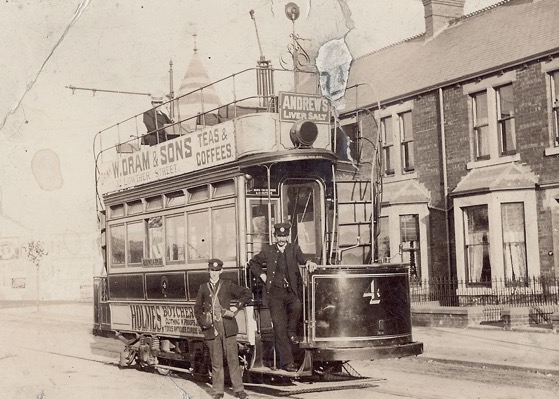
The crew of Tramcar No 4 captured at the Warwick Rd Terminus in 1901. Photo reproduced with kind permission of the Tullie House Museum and Art Gallery, Carlisle.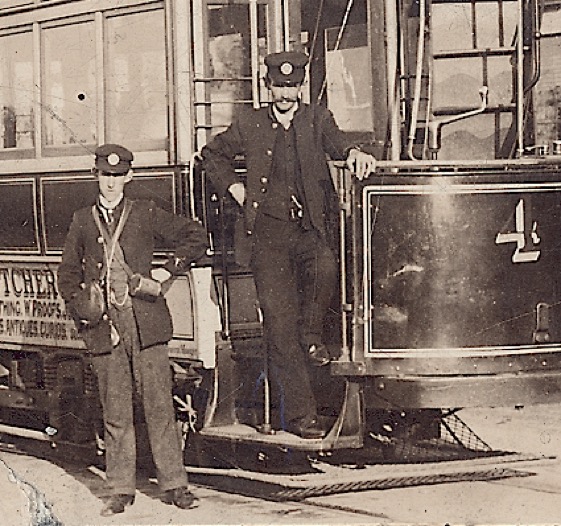
An enlargement of the above photograph showing the conductor and the motorman, both in early single-breasted uniforms and soft-topped caps, the latter bearing the prominent round cap badge shown below.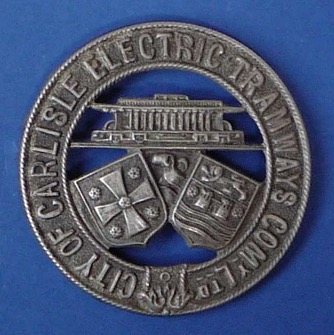
A City of Carlisle Electric Tramways Company cap badge — nickel. This was worn from 1900 onwards, but was probably displaced around 1912. Author's Collection.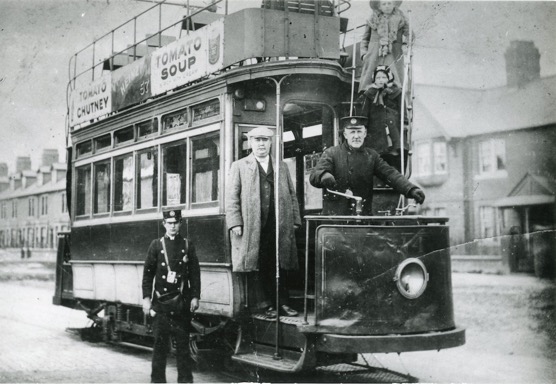
A rather battered Tramcar No 14 at the Newtown Terminus —photo undated, though purportedly taken in 1905. The conductor is wearing a smart drooping-peak cap, whereas the motorman sports a tensioned-crown peaked cap, strongly suggesting that the latter were introduced that year. The little girl on the steps was called Lilly, and went on to become the Mother-in-Law of author and broadcaster, Hunter Davies (thanks to John Perkins for this information). Photo courtesy of the National Tramway Museum. 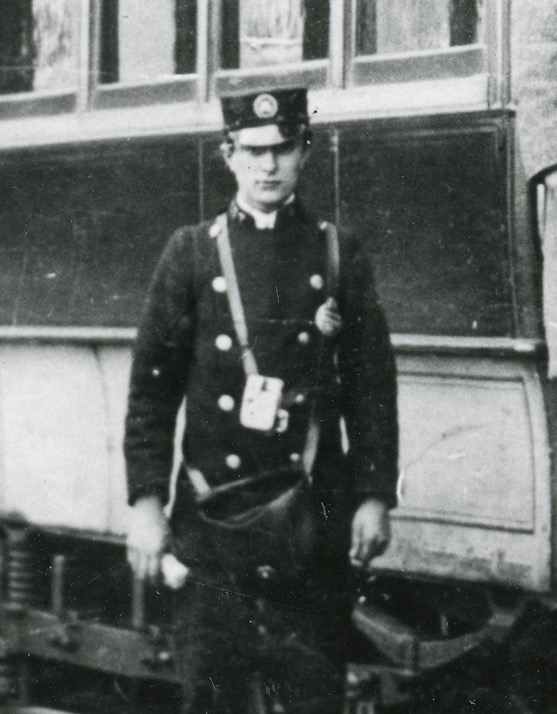
An enlargement of the above photograph showing the conductor in his double-breasted, lancer-style tunic, drooping-peak cap and prominent cap badge. A round licence badge is attached to his cash-bag strap, almost certainly the same pattern as that depicted below.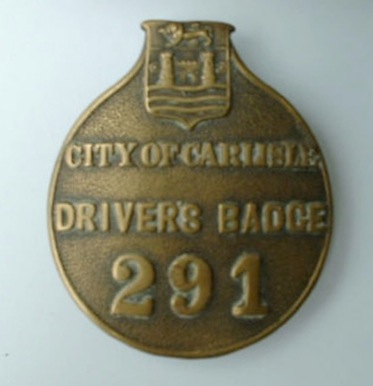
A City of Carlisle motorman's licence badge — brass. 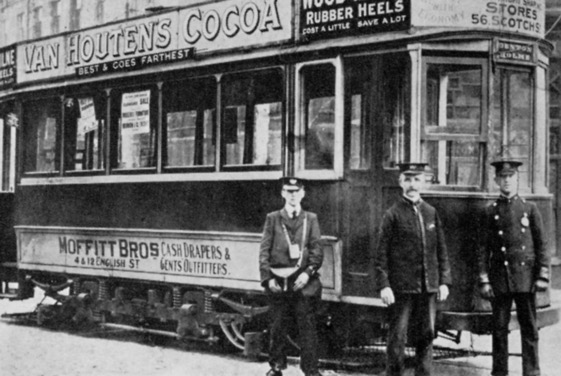
A conductor, an inspector and a motorman pose with Tramcar No 2 at Viaduct Corner in 1908. Tramcar No 2 was actually a one-man operated vehicle, so it is unclear why both a conductor and a motorman are present, though the former appears not to be wearing a uniform, so could well be a trainee. Photo courtesy of the Tramways and Light Railway Society, with thanks to David Voice.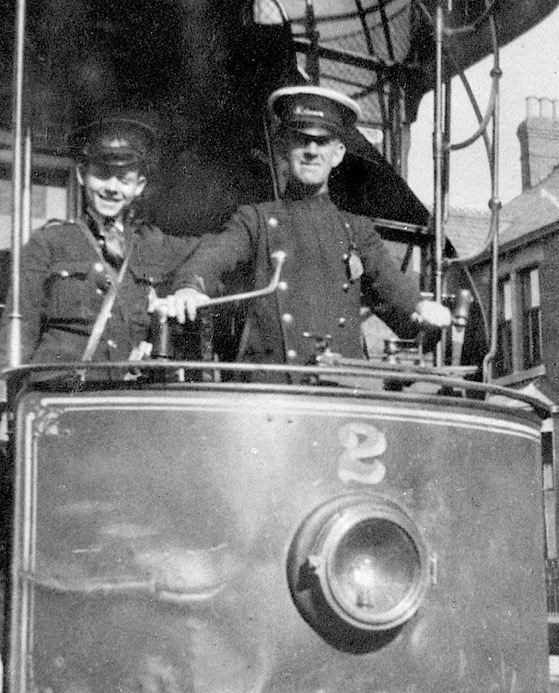
The crew of a rather battered-looking Tramcar No 2 (the second car to bear that number) at Newtown terminus — photo undated, but almost certainly taken in the mid-to-late 1920s. By this time, conductors were wearing single-breasted jackets with stand-up collars and epaulettes. The large, round cap badges had also gone, possibly since circa 1912, being replaced by standard, off-the-shelf script-lettering grade badges. With thanks to the National Tramway Museum. 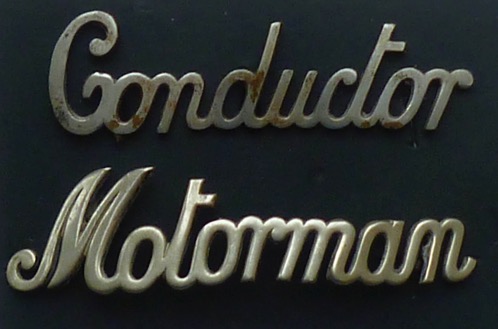
Standard off-the-shelf, script-lettering grade badges of the type probably worn by CCETCo tramcar crews from circa 1912 onwards. In the case of Carlisle, these were probably nickel to match the buttons. Author's Collection.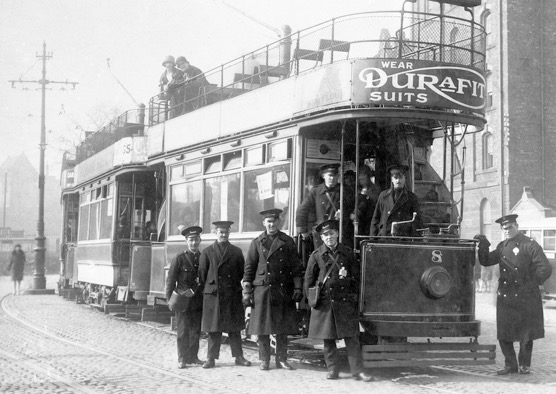
A gaggle of tramway staff wait in Caldewgate for Carrs Biscuits workers to emerge from the factory — photo taken some time in 1927. With thanks to the National Tramway Museum. 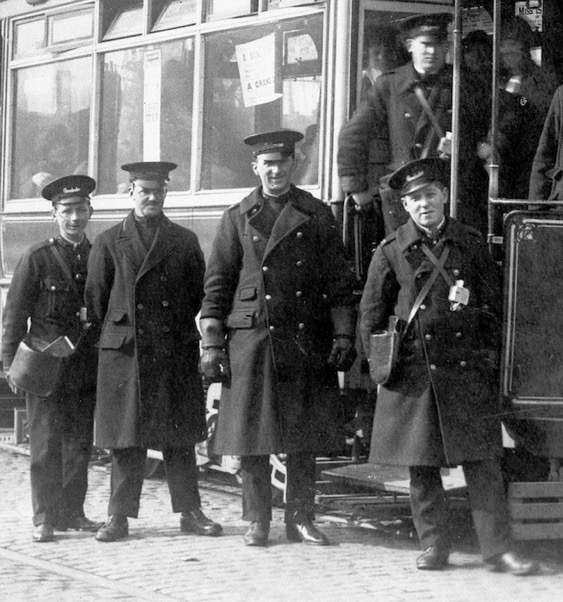
All the crewmen, with the exception of the inspector (second from the left) are wearing standard, off-the-shelf, script-lettering cap badges.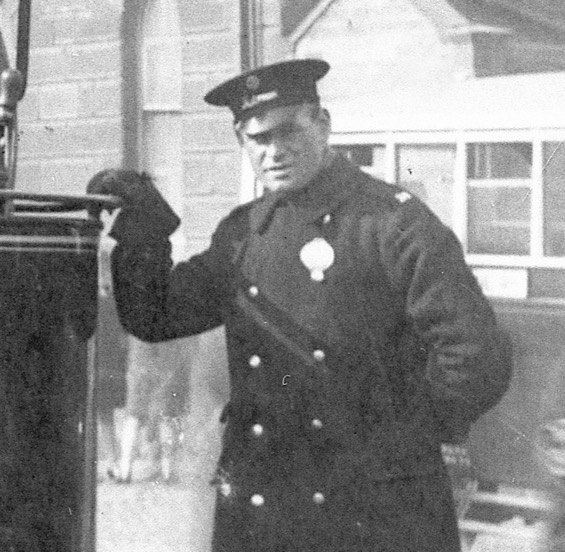
Another blow-up of the above photo, this time showing the motorman, with employee number on his epaulette and a municipal licence badge suspended from his greatcoat (the only individual depicted who has one). He also has a small round cap badge of unknown pattern — this is considerably smaller than the round cap badges worn in former times.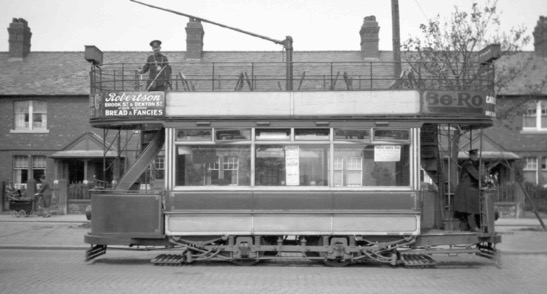
The crew of an unidentified tram pose for the camera of Dr H Nicol at the Newtown terminus on the 10th May 1931. With thanks to the National Tramway Museum. 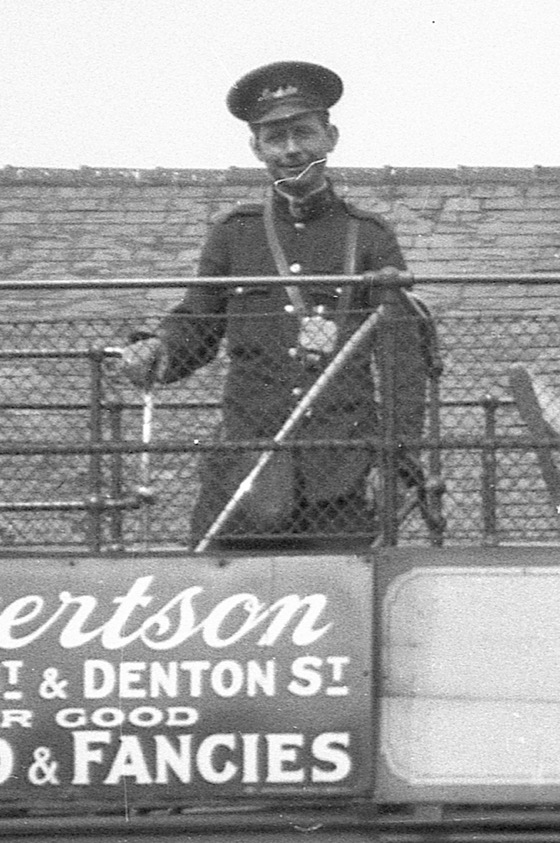
An enlargement of the above photograph showing the conductor. With thanks to the National Tramway Museum. 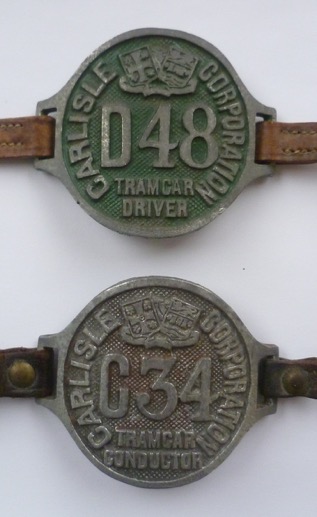
Tramcar Driver (green) and Conductor (red) armbands. As these armbands are not seen in any surviving photographs, it is tempting to speculate that their use was probably transient, possibly because they must have been very awkward to put on (without assistance). Author's Collection.
Senior staff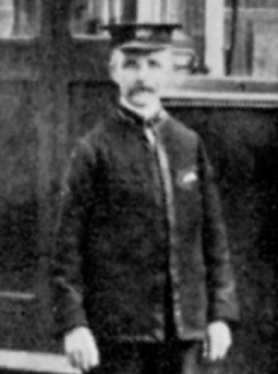
A CCETCo Inspector, taken from the 1908 'Viaduct Corner' view above.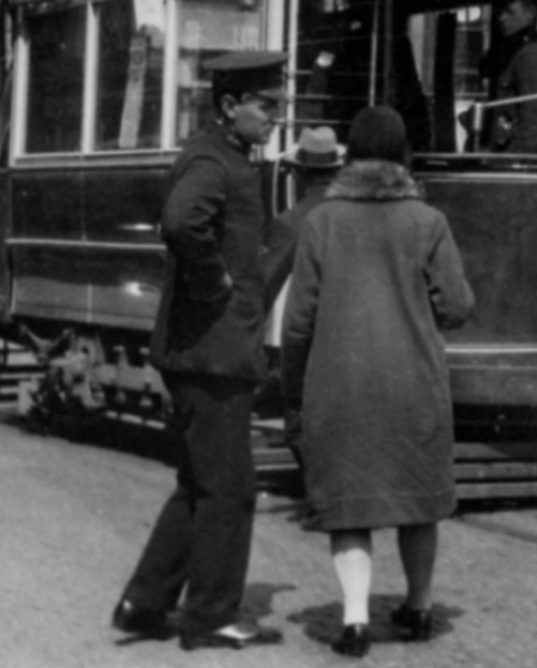
An inspector in conversation with a prospective passenger in the Market Place, circa 1927. Photo courtesy of the Tramways and Light Railway Society, with thanks to David Voice.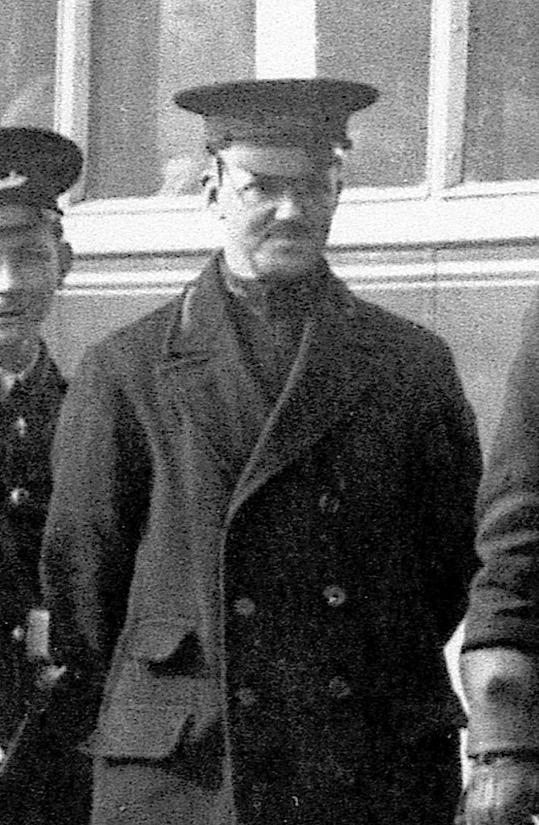
An enlargement of the 1927 shot in Caldewgate (see above) showing the inspector. His grade is embroidered on his overcoat collars, as well as the stand-up collars of his jacket (underneath).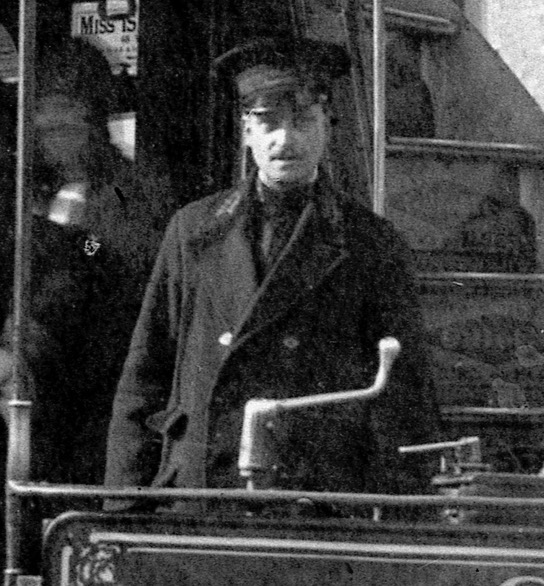
A close up of the senior figure on the platform of Tramcar No 8 from the 1927 Caldewgate photograph above. He appears to have two lines of embroidered script-lettering on his overcoat collars and cap, strongly suggesting that he was the Chief Inspector. With thanks to the National Tramway Museum.